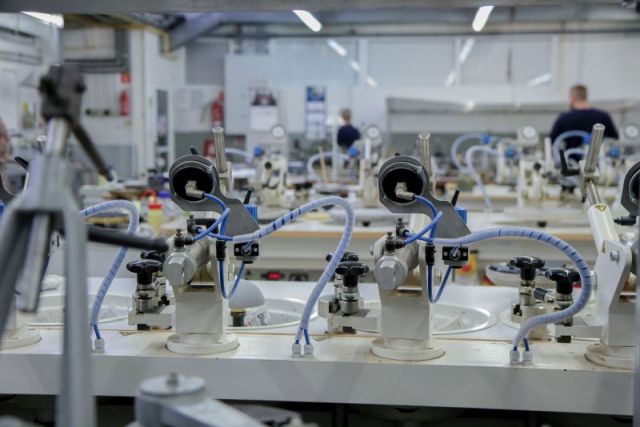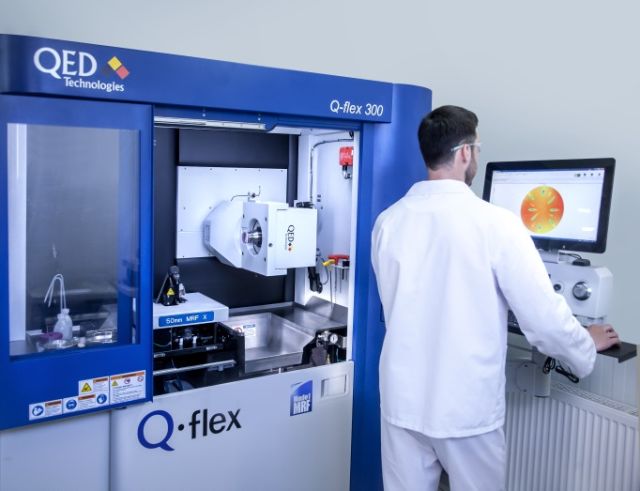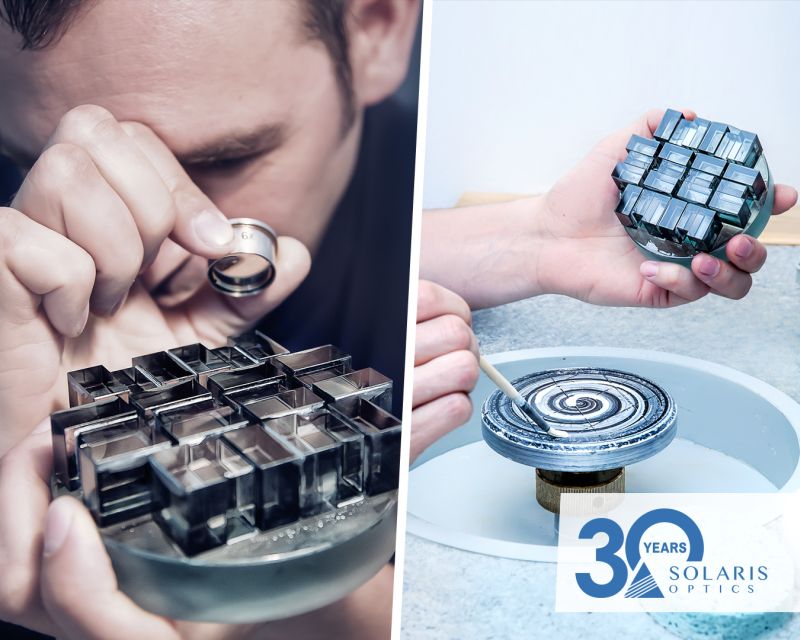Optical Polishing Technologies – Review
Published: May 30, 2021
Optical polishing is one of key production steps when it comes to performance and quality goals of today’s optics. In this article we discuss the most common polishing techniques for high-precision optics.
Optical polishing is a finishing process that is crucial to meet the flatness, thickness, or finish specifications of high-precision optical systems. Luckily, advancements in this area allowed to constantly push the envelope in terms of possible surface smoothness and accuracy to obtain. While almost all polishing methods involve the removal of a certain amount of material from the surface, there is rarely one size fits all. Depending on materials, sizes, geometries and surface finish requirements, engineers need to choose an optimal approach to achieve the desired effect. Each available technique uses a unique method to remove the layer of material and has its own strengths and weaknesses.
Pitch Laps and Polishings Pads – Traditional Techniques
Pitch polishing is a traditional technique for finishing optical surfaces known for its precision and accuracy. The method uses polishing pitches stroked over the optical surface to obtain a high level of flatness, low surface roughness, and cosmetic quality with minimal surface defects. Pitch is obtained through the distillation of tar from wood or petroleum and is formed to fit the optical surface to be polished. Thanks to its softness it does not scratch the surface but when used with polishing abrasive, it reduces the surface roughness and provides exceptional quality. There are many fine polishing compound types available on the market, including cerium oxide, alumina, colloidal silica, and many proprietary solutions from multiple vendors.

Fig. 1. Optical polishing facilities – Solaris Optics
Pitch polishing is regarded as an ultra-precise method that offers high quality and flexibility in terms of fabricated components, including lenses, optical flats, prisms, or filters in a wide range of geometries and sizes. However, low efficiency and the need for strict manual control and maintenance have limited its use to low-volume, custom parts where the emphasis is on accuracy and performance, not efficiency and output. This has led to increased interest in the use of synthetic polishing pads which strike a good balance between performance and productivity. This high-speed polishing method uses pads made of foam material, such as polyurethane, which is pressured against the optical surface to perform material removal. The polishing is a combination of mechanical and chemical processes, which means engineers are to determine the optimal pad type and polishing compound for their applications. The pads can operate at much higher speed and pressure compared to pitch laps, which led to an exceptional output increase.
In contrast to pitch laps, pads don’t conform to the shape of the finished component and thus require a surface which is already fabricated to high precision. The range of possible uses is narrower, but still, pads are proven to meet surface finish and figure specifications for even demanding applications. Thanks to its cost- and time-effectiveness it has become a standard technology for high-volume finishing of e.g. ophthalmic lenses, precision optics, mirrors, and other optical components made of a variety of materials.
Continuous polishing is a technique designed fpr finishing flat surfaces, a task that is difficult with conventional methods. The fabricated part is placed on an annular pitch lap which is several times larger and rotates continuously. To achieve uniform wear, the part is held by holders in a way that allows for synchronous rotation with the lap. To ensure the flatness of the lap, a large flat conditioner is used. For parts with two parallel faces, it is possible to use twin polishers with a lap on top and bottom of the part polishing both surfaces simultaneously. Continuous polishing is capable of producing high-quality, smooth flat surfaces in sizes of up to one meter in diameter.
Learn more about Solaris Optics traditional polishing services.
The traditional approach meets expectation of many todays applications. Nevertheless, the evolving shapes of optical surfaces as well as the ever increasing surface quality requirements have been pushing egnineers towards development of new, more advanced polishing methods.
New Mechanical Polishing Processes
Several novel techniques have been developed capable of fabrication of aspheric and freeform optics with a high level of accuracy.
Bonnet polishing is a sub-aperture method that uses a spinning inflated rubber membrane in a spherical form covered in polyurethane or other polishing material. The bonnet is inflated by air pressure and when pressed against the surface conforms to the aspheric or freeform geometry. Removal rate depends on the type of tool and abrasive slurry used and is a function of dwell time, speed and pressure.

Fig. 2. Optical polishing MRF – Solaris Optics
Another example of a mechanical method is fluid jet polishing based on a stream of abrasive slurry projected at high pressure at the piece through a nozzle. The impact of the abrasive particles in the slurry removes material from the surface at a rate dependent on medium characteristics and working pressure.
The ion beam figuring method uses an ion gun to bombard the optical surface with the ions and thus removes the material in a highly controlled and predictable way. The contactless technology is well established to polish custom optics in diameter of up to thousands of millimeters with high-precision, low errors, and no sub-surface or edge defects. Heavily accelerated ions reach the surface with considerable kinetic energy causing atom sputtering from the target surface. The method produces high-end surface quality with nano-precision, but requires vacuum conditions and has a relatively low material removal rate. Hence, it’s usually used as a corrective polishing method after the piece was pitch polished. The high cost and processing times have prevented this method from being used in volume production.
Another contactless technique is a high-intense laser beam, usually from CO2 source, which can be used for melting and ablating a thin surface layer of optical material to reduce roughness and improve figure quality. Melting of the material leads to smoothening of the surface thanks to surface tension in the softened layer. No material removal takes place as the surface subsequently solidifies. The method offers a promise of high-precision finishing of freeform optics, does not generate any waste and recent advancements have considerably shortened processing times. However, the cost of laser polishing equipment remains a consideration.
Magnetorheological finishing (MRF) is a relatively new but already well-established technology that allows the fabrication of mild aspherical optics, or high level polishing of surfaces, which meet even the strictest specification. MRF finished optics can achieve exceptional form accuracy with figure error as low as ~1 nm RMS, mid-spatial frequency errors of ~1 mm, and surface roughness of ~1 Å RMS. The method involves magnetorheological fluids which contain magnetizable particles and form a polishing layer over a rotating wheel with a magnet under the surface. As the wheel rotates, the polishing agent is pressed against the worked surface and material removal is performed in a deterministic manner. Although being a sub-aperture technique, MRF has proven to be an efficient and precise method for the fabrication of optical pieces across a wide range of geometries and sizes. A prime example is five 204mm mirrors fabricated by Solaris Optics S.A. for Paranal Observatory using MFR, stress mirror polishing, and SSI metrology. The use of MRF allowed to achieve 22.4 nm PVr and <λ/20 PV across the full aperture.
Summary
In the above article we reviewed the main mechanical polishing technologies, as used in industry. As mentioned it is always up to an engineer to select one of those. Solaris Optics engineering & production team will be happy to answer your questions regarding your polishing needs!
***

